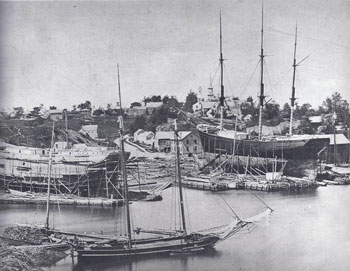B A C K T H E N
Yarmouth Harbor With
No
Interstate Highway

Photo courtesy of Chansoneta Emmons; Cutler Memorial Library, Farmington, from the Historic Maine Photo Collection, Department of Special Collections, Raymond H. Fogler Library, University of Maine
1864. Yarmouth Harbor with no interstate highway cutting across its head. “Royall’s River,” running from “Sabbaday Pond” in New Gloucester, is spanned by the birdge; the rich river valley was stained by the blood of Indian and settler.
The ships Eldorado and Detroit are on the stocks at the Walker and the Blanchard yards, respectively. At Loring’s yard, at right the bark Esther and the brig Winifred are under construction. The schooner in the foreground, lying at Parson’s brickyard, is the Margaret. Other Yarmouth schooners, the George and Emily and James Garcelon, lie elsewhere. A scow sloop piled high with kilnwood, lies at the brickyard. The Eldorado’s rudder is on the wharf; both wharves feature overhanging shipyard privies.
From 1795 through 1890 Yarmouth built thirty-eight ships, fifty-oe barks, sixty brigs, eighty-one schooners, and twenty sloops. Of the largest vessels, fourteen were ships built by the Seaburys for the Blanchards, the Detroit among them. In 1874 a dozen vessels were built. Houses of captains lined the vilage streets. E. C. Plummer gives us a schoolboy’s tour of the head of the harbor:
In Blanchard’s yard on Union Wharf, is the magnificent hull of what I hear men proudly say is one of the biggest ships ever built in the State of Maine. Near it, and a little west of Royall River bridge, a barkentine approaches completion under the eyes of Hutchins & Stubbs; while on that broad yard just east of the river, two brigs and a bark...bear testimony to the business-getting abilities of “Master” Giles Loring....
In place of that steel structure now spanning the river is a wide wooden bridge....At the northwest point...is Craig’s sawmill, its ever busy machinery fillling all the air with sound.... At its easterly end is the grain mill, always sending forth the subdued hum of those old-fashioned millstones for which great waongs, with huge blue bodies, come lumbering along this highway with corn...in a portion of the basement.... Nicholas Grant and his sons have a factory for the production of tackle blocks and deadeyes, of which so many are required in the rigging of ships. On the harbor side...is an unpainted three-story building, its basement used for the storage and turning of treenails.... The second floor...is given over to [ship] joiners, who are preparing he eleborate cabin finish...while the topmost story is a boarding house for...carpenters.... On Central Wharf stands a great red warehouse, relic of those old days when so many West India craft brought their cargoes to every sizable port.... Many boys of my time will recall the delight we took...turning the great wheel which operated a windlass that had...hoisted to the upper floors hogheads....
On Baker’s Wharf... is the great iron kettle in which lobstermen boil the victims of their traps to prepare them for market, on which occasions any boy...[with five cents] can secure a good-sized lobster for his special delectation.
In each of these three shipyards stand smoke-stained blacksmith shops, where thousands of bolts are cut...and tons of broad bar iron fashioned into massive mast caps, chain plates and other ship fittings....
Captain Charles Oakes recalled school being dismissed in his childhood so that the scholars, with joyous whoops and yells, could race the half mile to watch the launching of the ship S. C. Blanchard. The upper masts and yards, sticky as flypaper from oil or varnish, rested on the ground on skids, and the small boys, Oakes among them, found much enjoyment racing back and forh over them, yelling with glee as their bare feet stuck to the shining surface. In 1882, as third mate of the Blanchard, Oakes helped to cut away those same spars in a failed effort to relieve the doomed vessel (the break of her poop had been broached by a rogue spare spar) in a fierce gale off Cape Horn.
The Detroit was built for the command of Captain Samuel S. Thomas, of Yarmouth a prosperous shipmaster from the old school. A bachelor, he owned a grand house occupied by his four sisters. A former Yarmouth boy recalled the only time the captain spoke to him in the course of a voyage, during a trick at the wheel: “Henry, does your mother keep a cow?” The Detroit was a fortunate ship, primarily involved in the coal and guano trade between Europe and South America. In 1895 she became a coal barge at Acapulco.
The Eldorado was similarly employed before being sold to Pacific Coast owners. On April 1, 1887, under Captain Sylvanus Humphrey, of Yarmouth, she was lost off Cape Flattery with all but two hands drowned. During the previous winter months two other fine Maine-built ships with Maine captains, the Harvey Mills and the St. Stephen, were lost off the Cape. Of the three crews, only five men survived. h
Text by William H. Bunting from A Day’s Work, A Sampler of Historic Maine Photographs, 1860-1920, Part II. Published by Tilbury House Publishers, Gardiner, Maine, 800-582-1899.
